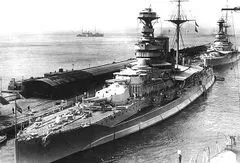
Unlucky Seal
An unlucky seal at the shipyard of the Paris Commune in Gdynia. Photo Collection Zbigniew Sandac
April 27 this year. at the repair shipyard in Gdynia, the Nauta capsized and partially sank, the floating dock, along with the repaired Norwegian chemical vessel Hordafor V, was on it. Some media reported that this was the first such case in Poland. It is possible that a ship and dock have never sunk here before, but there have been other cases of ship sinking at the shipyard.
On a stormy Christmas Eve in 1980, he broke free from his confinement at the shipyard. The Paris Commune in Gdynia is a large Norwegian car carrier Höegh Trader (B-487/1). It hit the center of the hull of the Panama Bah-Kim (B-533/12) cargo ship under construction and sank.
The second case, which I describe in detail, is the flooding and subsequent removal of the freezing trawler B-18/1 Foka. She, like Hordafor V, capsized to starboard and partially sank, even at the same time - between 13 and 00 hours. If this story in Nauta had happened in the 14s, the Polish Ship Salvage Service would probably have dealt with it, and the shipyard would not have had to turn to foreign companies for help. At that time, the company had made great strides in finding shipwrecks.
At that time, the seal was our largest fishing vessel, the prototype of a series of 9 pieces built by the Gdynia Komuna for the Odra Swinoujscie. At the plant, the head of production, engineer. Yaskulkovsky, the meeting on this trawler took place on September 3, 1964. It was attended, in particular, by the construction manager of the block, engineer. Felician Lada and Head of the Dock Department, Master of Science. Zeno Stephansky. It was also decided to dock the ship there, i.e. take it out of the water to carry out the necessary repairs and paint work, as well as align its approximately two-meter trim to the stern.
The next day, Eng. "Lada" contacted the design bureau and asked to determine the conditions for ballasting the vessel before docking. These conditions were determined by eng. Yagelsky from the Department of Theoretical Calculations based on documentation and observations of the draft of the ship. For 200 tons, he calculated the amount of additional ballast (water and solid) needed to fit on the seal's nose.
As a result of these activities, Eng. Lada was transferred to engineer. Stefanski on the phone with ballasting data. In addition, he agreed that the anchor chain should be placed in the chain chambers, and the anchors should be on the deck, which the workers of the Heavy Locksmith Department should have done. Perhaps the missing permanent ballast needed to be supplemented after consultation with the Department of the Docks.
At this time, Stefansky introduced master Pastushka, master Czesław Zeika and pilot Bronisław Dobbek to work on the trawler. Shepherdess was to take care of ballasting the tanks with water, Zieek was to prepare and arrange permanent ballast after agreeing the site with the trawler builder, and Dobbek was to carry out the work of towing and laying the ship dry. doc. Stefanski took care of dock preparation and docking operations.
On September 4, the tanks were filled with water, and the next morning, the head of the Dock Administration ordered Zeika to prepare permanent ballast. 9 containers of 5 tons of weight were used.

